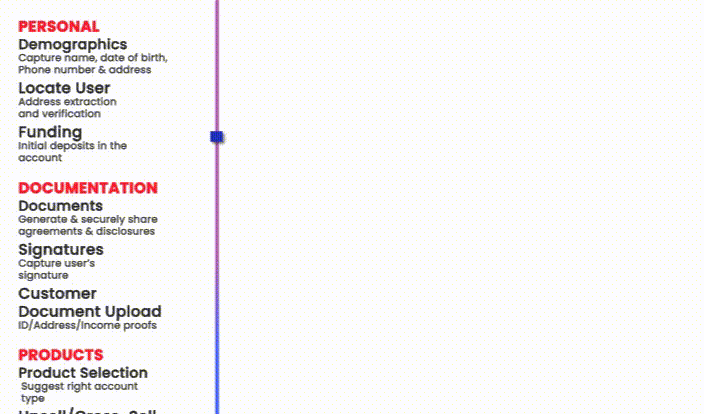Designing a seamless process for digitalizing customer onboarding in Banking
Publish Date: June 1, 2021Let your customer insights guide you towards building a successful digital onboarding framework
Ever since the emergence of new challenger banks in the likes of N26, Monzo and Revolut; the concept of digitalization in banking has been redefined. Traditional banks are constantly vying to be at par with the enhanced customer service offered by the challenger banks and edging towards offering end-to-end digital services. With COVID-19, the time is ripe to further accelerate towards this journey and address those missing links such as ‘digitizing customer onboarding’ that serves as the first check post to win customer loyalty in this banking battleground.
While the ongoing lockdowns has pushed many banks to take a leap toward sporadically implementing digital onboarding, most stumble in designing a sustainable business architecture that strikes the right balance between innovation, cost efficiency and improved customer experience.
My last blog focused on some of these common mistakes and provided a preview of the basic elements of consideration required to design a digital onboarding framework. In this blog, we will focus on a systematic innovation process aligning the traditional onboarding steps with digital components, to ensure value added service to the customer and profitable model for banks.
Before we delve into the process structure, let us first take into account the key technology components that when orchestrated together translate a typical process into a digital experience:
Digital components:
- Optical character recognition (OCR): Enables easy extraction of text-based data from documents, reducing manual input efforts for customers or bank representatives.
- Digital identities: A digitally stored government record of its citizens which could be anything like a digital ID card as the Aadhar in India, or the UAE Pass app, or Kuwait Civil ID PACI or US SSN that serve as a data verification point for banks.
- Biometrics: Yet another widely adopted means to verify customer identity is through the use biometric data such as individuals’ fingerprints, voice biometrics or iris scans or behavioural biometrics in the future.
- Facial authentication: Another anti-impersonation solution involves facial identification of the applicant against the picture provided in a document or taken through a selfie. By using a number of facial vector points to match with facial attributes of the picture, banks can authenticate the identity and even liveness check of the person.
- Real time check verification: To determine the genuineness of the customer, it is critical to run real-time tests against anti-money laundering, blacklist, fraud detection or even verifying the credit worthiness of the person.
- Digital smart eForms, eSignatures and consent: Digital onboarding remains fragmented if the customer has to keep juggling between downloading, scanning and uploading forms and documents. Digital components such as smart eForms ensures higher and faster completion rates. With a simple mobile interface, auto-fill and CRM-prefill and instant submission provision, they are easier to complete and submit from any device.
- Reduce onboarding time: As eForms, eSignatures are also gaining momentum, dismissing the traditional process of downloading, printing, signing, and scanning or faxing their consent forms with just a swipe of a finger. These basic digital components significantly reduce the overall lifecycle time of onboarding.
- Chatbots: Chatbots impersonating a human assistant can guide customers towards self-resolution of a problem by addressing a range of general as well as account specific queries depleting the need of a human agent.
- API platforms and CCM Software: Proven and robust APIs allow the systematic deployment of innovative solutions across business lines to completely digitize and streamline onboarding while maintaining the highest level of security certification. CCM Software ensures seamless onboarding of customers by proactively engaging with them and sharing timely and relevant communications on the channel of their preference.
- Using analytics to track real-time onboarding status: Using the insights from big data analytics, banks can trace real-time the status of an individual customer’s journey, time taken at each stage, friction point etc. These insights will help them improve and customize their offering, winning customer loyalty along the way.
The road towards digitalization, however, is not just about incorporating digital components into traditional structure. It calls for a re-prioritisation of strategy from the former customer acquisition models focused on traditional product driven marketing and sales strategy towards customer retention. Once a strategy is well-established, banks should deploy design thinking to craft a holistic process map representing their in-depth understanding of the customer lifecycle journey, the multiple engagement points and the challenges faced by customers. The next step is to incorporate these facts in the designing of their products and services and testing with customers through rapid prototyping. The digital technologies such as robotic process automation or artificial intelligence when integrated with the above designing approach enables agility and optimum cost efficiency supporting an innovation framework for a solution. A framework that strikes the right balance between automation, speed and simplicity along with personalization and human experience. In the last blog we saw how providing a customer-centric human experience forms the basis of a design framework.
Below are the key steps of standard process approach that ensures a simple yet innovative framework. These can be adaptable to suit the changing priorities of banks and financial institutions:
1. Customer verification and proofing
The traditional verification process that typically involves verifying acclaimed customer identity from multiple sources can be done easily through digital onboarding with elements such as digital identity in no time. Even anti-money laundering (AML), fraud detection and blacklist checks can be done real time saving time and cost for the bank. Blockchain can be leveraged to tap into a centralized repository for checks against duplication if any. Optical character recognition saves the cumbersome data entry time of both the customers and the bank representative. Quicker data verification is essential for traditional banks in their competition with the digital banks to quickly accumulate customers and maintain higher market share.
2. KYC – Standard process
As opposed to the traditional KYC procedures that involved branch visits and heavy paper work, digital onboarding can be done in a matter of time with faster and flexible access to banking service, thereby improving customer experience.
Technologies such as automated biometric verification either through fingerprints or iris scan as against in-branch visits makes KYC faster and more convenient for customers. Facial authentication through video conferencing is also increasingly gaining momentum. KYC process may vary depending on the regulation of a country. In the UK, for example, sending a photo and a picture of customer ID is more than enough as only photo-identification is required. While in some parts of Middle east, video-identification via a video chat is critical to prove an identity. In India, the Reserve Bank has permitted Video-based Customer Identification Process (V-CIP) as a consent-based alternate for establishing the customer’s identity.
3. Fund account
Getting your customers onboarded as early as possible is great, but if they don’t fund their accounts and become active, this can get very costly. Few quick wins:
- Offering loyalty points
- Online check deposits: Taking pictures of Cheques instead of manually depositing them, which is popular within the US
- Promotions to convert into a salary account
While these are the key elements of a standard processes, banks need to keep in mind that there is no one-size fit all. The process structure is subjective to their business strategy, different target customer segments, complexity of products and services and regulatory requirements of their country of operation.

The rules of traditional banking are getting rewritten. Digital-native customers demand instant onboarding for bank accounts, digital wallets, real-time money transfers, cashless or card-less transactions, and more. YASH Digital Onboarding Solution is a mobile-based self-service platform that empowers customer journeys with minimal fallouts, accelerated acquisitions, and deepened relationships.
Contact YASH Technologies to define your own process and offer an enhanced digital onboarding experience to your customers seamlessly.

















